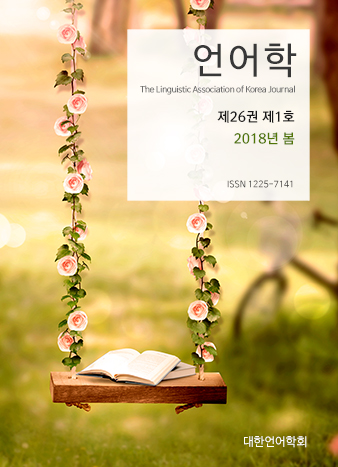대한언어학회 전자저널

26권 1호 (2018년 3월)
- 중국인 한국어 학습자의 자유 발화에 나타난 자음 대치 오류 연구 —초성과 종성 환경을 중심으로
-
백경미
Pages : 179-197
Abstract
Baek, Gyeongmi. (2018). A study on consonant replacement errors in the spontaneous speech of Chinese students studying Korean in Korea. The Linguistic Association of Korea Journal, 26(1), 179-197. The goal of this study was to characterize consonant replacement errors in the spontaneous speech data of Chinese learners of L2 Korean. For this study, I collected natural utterances from 100 Chinese students consisting of 50 intermediate and 50 advanced learners of Korean, and investigated whether specific consonants were replaced based on syllable structure. The results indicate that consonant replacement mainly occurred at syllable onset in word-medial position. It was found that advanced learners of Korean confused lax consonants with aspirated ones at syllable onset and learners of Korean confused lax consonants with fortis consonants at syllable onset word-medially. In addition, advanced learners of Korean confused /ㅇ/ and /ㄴ/, /ㄱ/ and /ㅂ/, /ㅇ/ and /ㄹ/ in word-final position. From the analysis of the results, I was able to find which articulation constraints and strategies work when non-native speakers learn the Korean language.
Keywords
# 제2언어 습득(L2 acquisition) # 한국어 교육(Korean education) # 자음 대치(consonant replacement) # 중국인 화자(Chinese speakers) # 한국어 발음(Korean pronunciation) # 자유 발화(spontaneou
References
- 김소야. (2006). 한국어 평음/경음/기음에 대한 중국인의 지각적 범주 연구. 이중언어학, 32, 57-79.
- 김지연. (2010). 중국인 자연발화 발음 오류 분석 연구. 충남대학교 석사학위 논문.
- 김태경. (2014). 중국어 모어 화자의 한국어 음소 변별에 대한 연구. 국제어문, 62, 405-425.
- 김태경, 백경미. (2010). 학령전 아동의 발음 오류에 관한 연구 -음운 변동을 중심으로. 국제어문, 49, 7-34.
- 김태경, 백경미. (2014). 제2언어로서의 한국어 습득 과정에 나타난 자음 탈락 현상 연구 -중국인 한국어 학습자의 자발화를 대상으로-. 국제어문, 63, 257-281.
- 노금송. (2000). 중국인을 대상으로 한 한국어 발음 교육. 동아대학교 석사학위 논문.
- 박시균, 최경복. (2014). 중국인 학습자의 겹받침 오류분석 -겹받침 앞뒤 선택의 오류를 중심으로-. 언어학, 22(4), 317-338.
- 백경미. (2012). 제1언어와 제2언어로서의 한국어 발음과 형태 습득 비교. 한양대학교 박사학위 논문.
- 신지영. (2015). 말소리의 이해. 한국문화사.
- 신호철. (2003). 한국어 유음의 발음 교육에 대한 연구 -중국어 모어 화자를 중심으로-. 국어교육학연구, 16, 253-272.
- 양순임. (2007). 연음규칙 적용에 따른 오류 분석 -중국인 학습자의 중간언어를 대상으로-. 한국어교육, 18(3), 123-144.
- 오발. (2014). 중국인 한국어 학습자의 구어 자료에 나타난 중간언어 양상. 중국조선어문, 3, 45-51.
- 위원징, 홍미주. (2013). 중국인 학습자의 청취·발음 오류 분석을 통한 한국어 평음·경음·격음 교육 방안 연구. 한국어교육, 24(4), 155-191.
- 윤영해. (2008). 중간언어 음운연구를 바탕으로 한 발음교육의 효과 연구 -중국인 화자들의 받침 발음을 중심으로-. 한국어교육, 19(2), 239-256.
- 윤정기. (2012). 음운규칙 적용에 따른 중간언어 연구 -중국인 초급 학습자의 발음을 중심으로-. 한어문교육, 27, 539-561.
- 이은주, 우인혜. (2013). 중국인 한국어 학습자를 위한 한국어 /ㄱ. ㄷ. ㅂ/ 발음 교육 방안 -한국어 음절 구조를 중국어 음절 구조에 반대로 적용하여-. 새국어교육, 97, 327-359.
- 이정희 외. (2013). 대화 분석을 통한 외국인의 한국어 구어 사용 연구. 도서출판 하우.
- 이현복, 심소희 편역. (1999). 중국어 음성학. 교육과학사.
- 장향실. (2011). 중국인 학습자의 한국어 음운규칙 습득 연구. 이중언어학, 46, 367-390.
- 정효주, 김영주. (2012). 중국인 학습자의 유음화 발음 오류 연구. 한말연구, 31, 283-306.
- 한재영 외. (2008). 한국어 발음 교육. Hollym.